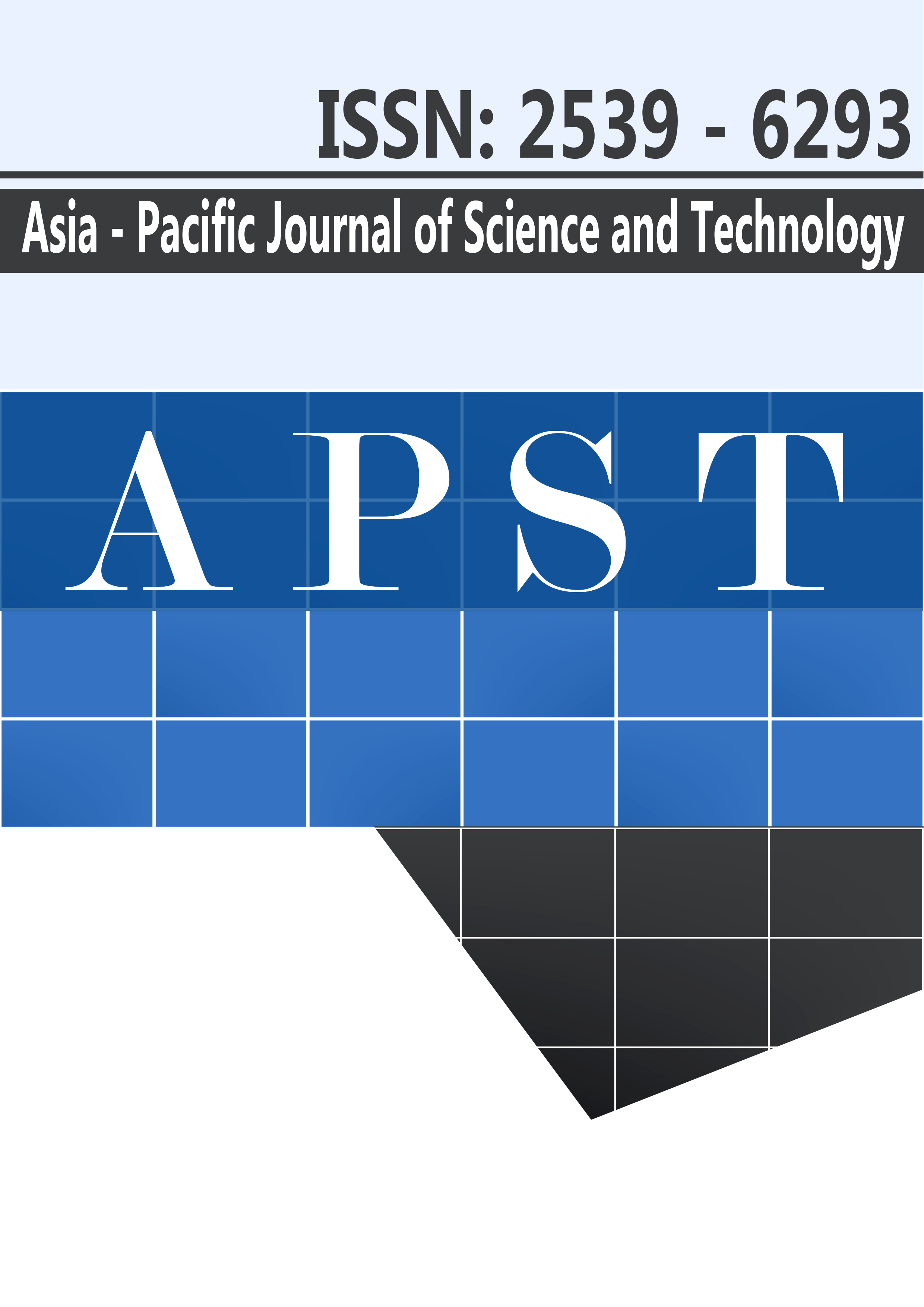A prototype of an automatic mattress turning device: a study of Interface pressure at bony prominences in normal subjects
Main Article Content
Abstract
This study was to test an interface pressure at bony prominences when using a prototype of an automatic mattress turning device (AMTD) to reposition a body while lying in a hospital bed. The AMTD consists of a set of air bellows (two large in the middle and two lateral small ones) placed under a 4 inches foam mattress and microcontrollers with air pumps and solenoid valves controlling inflation and deflation of each air bellow. After inflation, it lifted one side of the mattress up so that a body on the mattress turned from supine to a 30° lateral tilt position. Using an XSENSOR pressure mapping system, peak pressure was recorded (mmHg) and peak pressure indexes (PPIs) (mmHg/cm2) over bony prominences of the body of 20 normal volunteers were calculated and compared between the supine and the 30° lateral tilt positions. In the 30° lateral tilt position, the mean peak pressure reduced significantly at the occiput (30.75, 27.26, p = 0.003), the sacroccygeal area (35.99, 27.26, p < 0.001) whereas the mean PPIs also reduced significantly at the occiput (21.53 to 14.93, p < 0.001), the scapula (21.65 to 18.78, p 0.011), and the sacrococygeal area (33.76 to 27.53, p = 0.001). The peak pressure and the PPI were highest at sacrococcygeal area in supine and decreased significantly when a body was turned to a 30° lateral tilt with this automatic mattress turning device.
Article Details
References
[2] Verschueren JH, Post MW, de Groot S, van der Woude LH, van Asbeck FW, Rol M. Occurrence and predictors of pressure ulcers during primary in-patient spinal cord injury rehabilitation. Spinal cord 2011;49:106-12.
[3] Kovindha A, Kammuang-lue P, Tongprasert S, Komaratat N, Mahachai R, Chotiyarnwong C, Pattanakuhar S. A preliminary report on outcomes of inpatient rehabilitation services from tertiary care facilities in the Thai Spinal Cord Injury Registry (TSCIR) project. J Thai Rehabil Med 2017;27:101-7.
[4] Krause JS, Saunders LL. Health, secondary conditions, and life expectancy after spinal cord injury. Arch Phys Med Rehabil 2011;92:1770-5.
[5] National Pressure Ulcer Advisory Panel, European Pressure Ulcer Advisory Panel and Pan Pacific Pressure Injury Alliance. Prevention and treatment of pressure ulcers: quick reference guide. Osborne Park: Cambridge Media; 2014.
[6] Moore Z, Cowman S, Conroy RM. A randomised controlled clinical trial of repositioning, using the 30 tilt, for prevtention of pressure ulcers. Journal of Clinical Nursing 2011; 20:2633-44.
[7] Groah SL, Schladen M, Pineda CG, Hsieh CH. Prevention of pressure ulcers among people with spinal cord injury: a systematic review. PM&R 2015; 7:613-36.
[8] Guttmann L. A new turning bed. Paraplegia 1965;3:193-7.
[9] Do NH, Kim DY, Kim JH, Choi JH, Joo SY, Kang NK, et al. Effects of a continous lateral turning device on pressure relief. J Phys Ther Sci 2016;28:460-6.
[10] Silpasupagornwongse S, Kumthornthip W, Assawapalangchai S, Prateepavanich P. The study of prevalence, risk factors and impact of low back pain among nurses and nurse-aids in Siriraj Hospital. J Thai Rehabil Med 2006;16:128-38.
[11] Gunningberg L, Carli C. Reduced pressure for fewer pressure ulcers: can real-time feedback of interface pressure optimise repositioning in bed? Int Wound J 2016;13:774-9.
[12] Wiggermann N. Biomechanical evaluation of a bed feature to assist in turning and laterally repositioning patients. Human Factors 2016;58:748-57.
[13] Sawattikanon N, Uttrarachon K, Pongvuthithum R, Sucharitakul T, Rangsri W. A prototype of automatic mattress turning device for pressure ulcer prevention. J Assoc Med Sci 2019;52:88-91.
[14] Lung CW, Yang TD, Crane B, Elliott J, Dicianno BE, Jan YK. Investigation of peak pressure index parameters for people with spinal cord injury using wheelchair tilt-in-space and recline: methodology and preliminary report. BioMed Res Int 2014;2014:508583.
[15] Källman U, Engström M, Bergstrand S, Ek AC, Fredrikson M, Lindberg LG, et al. The effects of different lying positions on interface pressure, skin temperature, and tissue blood flow in nursing home residents. Biol Res Nurs 2015;17:142-51.
[16] Amir Y, Tan FE, Halfens R, Lohrmann C, Schols J. Pressure ulcer prevalence and care in Indonesian hospitals: a multicenter, cross-sectional evaluation using an extended Donabedian model. Ostomy Wound Manage 2017;63:8-23.
[17] Landis EM. The capillary of the skin. Heart 1930;15:209-28.
[18] Shore AC. Capillarosocpy and the measurement of capillary pressure. Br J Clin Pharmacol 2000;50:501-13.
[19] Williams SA, Wasserman S, Rawlinson DW, Kitney RI, Smaje LH, Tooke JE. Dynamic measurement of human capillary blood pressure. Clin Sci (Lond) 1988;74:507-12.
[20] Anderson R, Kleiber C, Greiner J, Comried L, Zimmerman M. Interface pressure redistribution on skin during continuous lateral rotation therapy: A feasibility study. Heart Lung 2016;45:237-43.
[21] Woodhouse M, Worsley PR, Voegeli D, Schoonhoven L, Bader DL. The physiological response of soft tissue to periodic repositioning as a strategy for pressure ulcer prevention. Clin Biomech (Bristol, Avon) 2015;30:166-74.
[22] Sawattikanon N, Uttrarachon K, Kovindha A. Does a prototype of an automatic mattress turning device work with various types of hospital mattresses? J Thai Rehabil Med 2018;28:101-5.


